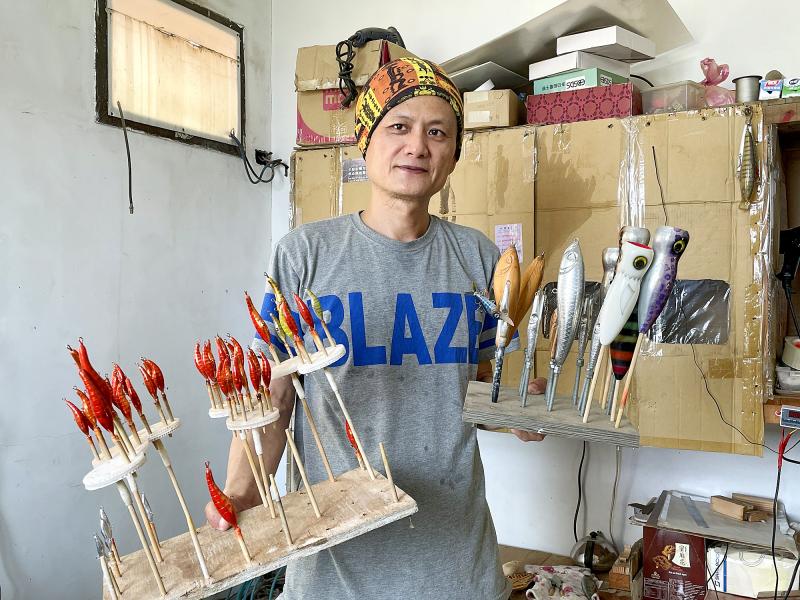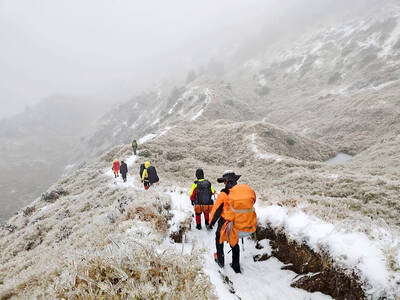A man in Kinmen County who left his job in construction due to a chronic illness has found a new calling making eco-friendly fishing lures.
Wang Tsung-lieh (王聰烈) said that his love of fishing motivated him to make lures for a living, adding that he makes them only with wood to prevent damage to the marine environment.
The pandemic has caused a dent in sales, but he is still working hard at making the fishing tackle, he said.

Photo: CNA
Wang was introduced to lure fishing by a senior classmate when he was 17, and later taught himself to make lures, he said.
“Lures do just as their name suggests — they lure fish in by mimicking smaller fish. Lures can move differently in the water depending on how you manipulate the fishing line,” he said.
Asked how he ended up in Kinmen, Wang said that his mother and two brothers moved to the county 20 years ago to work in construction.
After his mother and older brother later passed away in Kinmen he made the trip for the funeral, he said.
While there, he felt that his fate was to live in Kinmen, so he relocated to the county, he said.
However, after his muscle atrophy worsened he was unable to continue doing construction work, and decided instead to follow his interest making lures, he said.
“I had graduated from a vocational high school and was good at working with machine tools, so for me, making lures was not difficult,” he said.
Wang said that while making lures by hand could be considered an artisan craft, a knowledge of fluid mechanics is necessary to make the lures move well in water.
Wang said that his lures move vertically and horizontally, in a natural way that mimics the movement of real fish and are not affected by waves.
The lures take one to two weeks to make, and cost between NT$280 and NT$4,000, depending on the level of their complexity, he said, adding that his lures are priced higher compared with those sold on the market, which are made of plastic and mass produced.
“Unfortunately, most of those plastic lures break from the line and end up as marine waste,” he said.
Well-crafted lures also have the benefit of being a collectible item for fishers, he said.
“Fishing enthusiasts have the habit of taking photos of their catches. If the lure is visible in the shot, it’s not uncommon for other enthusiasts who see the photo to buy the lure from the person who made the catch,” he said.
However, despite the collectability and practical nature of lures, the relatively small number of fishing enthusiasts in Taiwan means that he has a small market to pitch his wares to, he said, adding that the pandemic has made sales even more challenging.
“But I’m not giving up. I hope in the future I can add some local Kinmen element to my lures to make them even more unique,” he said. “I want to forge ahead on this island.”

Trips for more than 100,000 international and domestic air travelers could be disrupted as China launches a military exercise around Taiwan today, Taiwan’s Civil Aviation Administration (CAA) said yesterday. The exercise could affect nearly 900 flights scheduled to enter the Taipei Flight Information Region (FIR) during the exercise window, it added. A notice issued by the Chinese Civil Aviation Administration showed there would be seven temporary zones around the Taiwan Strait which would be used for live-fire exercises, lasting from 8am to 6pm today. All aircraft are prohibited from entering during exercise, it says. Taipei FIR has 14 international air routes and

The Ministry of National Defense (MND) today released images of the military tracking China’s People's Liberation Army (PLA) movements during the latest round of Chinese drills around Taiwan. The PLA began "Justice Mission 2025" drills today, carrying out live-fire drills, simulated strikes on land and maritime targets, and exercises to blockade the nation's main ports. The exercises are to continue tomorrow, with the PLA announcing sea and air space restrictions for five zones around Taiwan for 10 hours starting from 8:30am. The ministry today released images showing a Chinese J-16 fighter jet tracked by a F-16V Block 20 jet and the

Snow fell on Yushan (Jade Mountain, 玉山) yesterday morning as a continental cold air mass sent temperatures below freezing on Taiwan’s tallest peak, the Central Weather Administration (CWA) said. Snowflakes were seen on Yushan’s north peak from 6:28am to 6:38am, but they did not fully cover the ground and no accumulation was recorded, the CWA said. As of 7:42am, the lowest temperature recorded across Taiwan was minus-5.5°C at Yushan’s Fengkou observatory and minus-4.7°C at the Yushan observatory, CWA data showed. On Hehuanshan (合歡山) in Nantou County, a low of 1.3°C was recorded at 6:39pm, when ice pellets fell at Songsyue Lodge (松雪樓), a

NO SHAME IN RETREAT: Hikers should consider turning back if the weather turns bad or if they do not have sufficient equipment, the Taroko park headquarters said Two people died of hypothermia over the weekend while hiking on Hsuehshan (雪山), prompting park authorities to remind hikers to bring proper equipment and consider their physical condition before setting out in the cold weather. Temperatures dropped over the weekend, bringing snow to high altitudes in Shei-pa National Park. One hiker, surnamed Lin (林), who on Friday was traveling with a group of six along the Hsuehshan west ridge trail, lost consciousness due to hypothermia and died, the Shei-pa National Park Headquarters said. On Saturday, another hiker, surnamed Tien (田), in a group of five on the southeast of the west